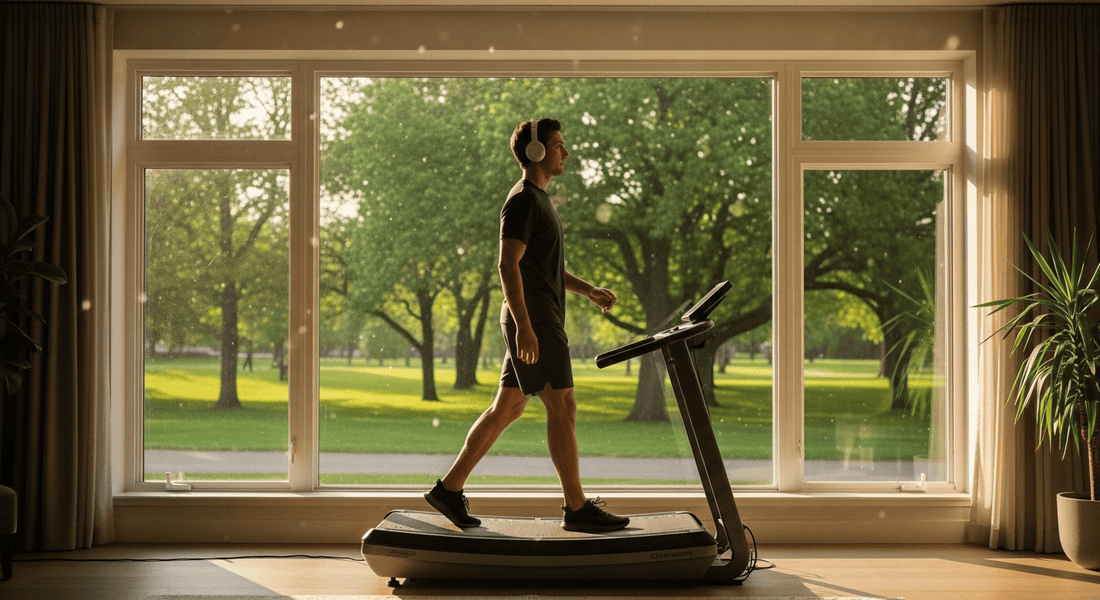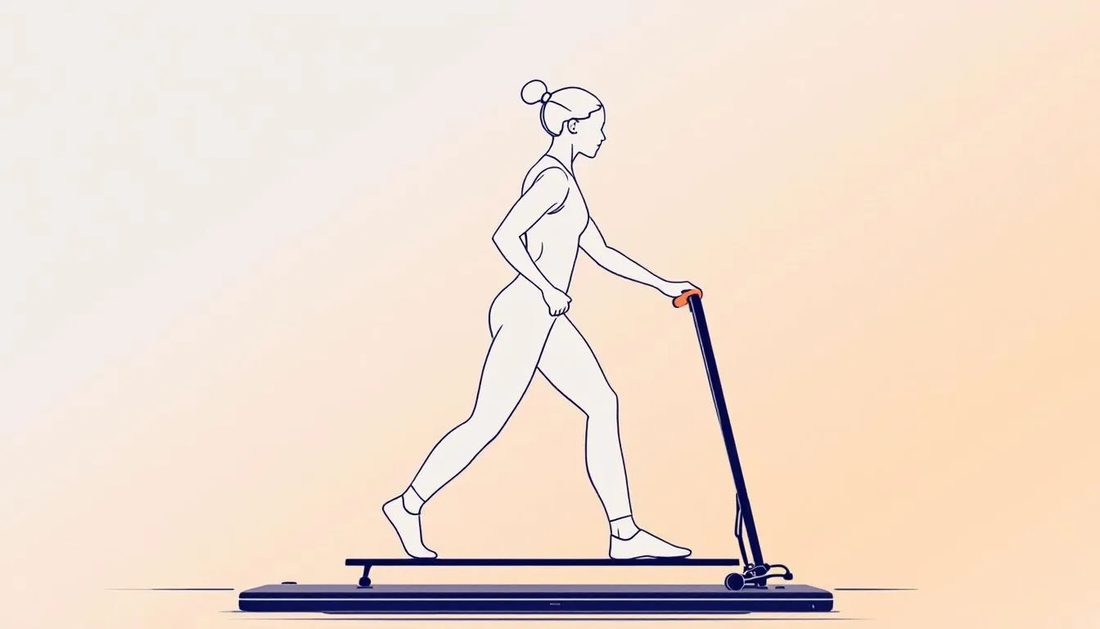Imagine getting your steps in while finishing a report, catching up on emails, or attending a Zoom meeting. For many remote workers, that’s now a reality—thanks to the rising popularity of walking pads and treadmill desks.
But what started as a quirky work-from-home trend has sparked real scientific interest. Researchers have been asking: Can walking while working actually help us focus better, feel better, and even perform better at our jobs? Phil Haacks' blog post highlights the health risks of sitting and the benefits of walking while working, providing further insight into why this trend is gaining traction. The short answer is yes—and the long answer is fascinating.
Let’s explore what science reveals about walking while working and why it might be one of the simplest ways to upgrade your daily workflow.
From Sedentary to Stimulated: A Shift in How We Work
We’re sitting more than ever—often 9+ hours a day—and it’s taking a toll on both body and mind. Both offices and house environments are seeing a shift toward more active workstations, as people look for ways to reduce sedentary time. While standing desks helped start the movement (literally), walking desks have taken it a step further.
Light-intensity walking at the desk isn’t just good for breaking up sedentary time. Taking more steps throughout the workday can help people lose weight and experience improved mood and more energy. According to a growing body of research, it may also enhance cognitive function, regulate mood, and boost energy levels without compromising work performance.
Equipment Options: Gearing Up for Movement at Your Desk
Choosing the right equipment is key to making movement a natural part of your workday. For many, a standing desk is a great first step, allowing you to alternate between sitting and standing to break up long periods of inactivity. If you’re ready to take it further, desk treadmills offer the ability to walk at a gentle pace while tackling tasks like data entry, phone calls, or even creative brainstorming.
Desk treadmills come in a range of styles, from compact walking pads that slide under your existing desk to full-featured treadmill workstations with adjustable heights and built-in controls.
No matter which setup you choose, both standing desks and treadmill desks can help increase your daily physical activity, boost energy, and contribute to more calories burned throughout the workday. By finding the right equipment for your needs, you’ll be well on your way to a healthier, more active work routine.

Cognitive Function: Does Walking Hurt Your Focus?
One of the biggest concerns people have is whether walking distracts from deep work.
A clinical study by the Mayo Clinic put this to the test. Participants rotated between sitting, standing, and walking desks while performing tasks that measured reasoning and concentration. The results? No drop in performance. In fact, some scored better while walking slowly on a treadmill (Mayo Clinic News, 2024).
One study found, in a meta-analysis of 18 studies, that while walking may slightly reduce typing speed (a marginal difference), it enhanced memory recall—suggesting the brain stays sharp, or even sharper, when we’re in motion (Journal of Physical Activity and Health). Researchers used detailed notes, including interview transcriptions and coding processes, to thoroughly document and analyze the data collected in these studies.
Stress and Focus: Walking Calms the Chaos
We often try to solve stress with breaks, coffee, or quick scrolls on our phones—but it turns out, a slow walk might be far more effective.
Using EEG scans and cortisol testing, researchers found that walking desks help regulate stress hormones and improve attention during the day. In one trial, participants walking at just 1.5 mph maintained full focus while performing complex cognitive tasks (Applied Ergonomics).
Rather than overstimulating the brain, walking seems to create a rhythmic state that lowers mental tension and sharpens awareness—a sweet spot for focused work.
Physical Perks Without the Sweat
Of course, one of the more obvious benefits is physical activity. But the unique value of walking while working is that it doesn't demand a wardrobe change or a gym session.
A meta-analysis involving over 350 participants found that treadmill desks increased energy expenditure by an average of 105 calories per hour and reduced sitting time by more than an hour each day (Journal of Occupational Health).
This light movement improves blood flow, posture, and metabolism—all while you’re catching up on spreadsheets.
Mood, Motivation & Mental Well-Being
If you’ve ever taken a short walk to “clear your head,” you already know how effective it can be. But when walking becomes part of your actual workday, those mental benefits compound.
In a study published in PLOS One, treadmill desk users reported better mood, less stress, and more motivation compared to those using standing desks. The combination of movement and task engagement appeared to create a more positive work experience overall (PLOS One Study, 2022). Some people also find extra motivation by tracking their activity and competing with friends, which can further boost mood and engagement.
It’s not just about being productive—it’s about feeling better while doing it.
What About Learning and Memory?
Some worry that multitasking between walking and working could hurt learning or long-term retention. Fortunately, the research doesn’t support that concern.
A 2015 cognitive study tested learning and memory while walking and found only a minor dip in task speed—but no impact on memory recall or comprehension later on (Cognitive Psychology, 2015). So, whether you're reading emails or writing reports, your brain keeps up just fine.
Why It Works: The Brain-Body Connection
On a biological level, walking helps regulate systems tied to stress, attention, and emotion. Moderate aerobic movement—even slow walking—boosts levels of BDNF (Brain-Derived Neurotrophic Factor), a key protein for memory and cognitive performance. It also increases IGF-1 and VEGF, which promote neuroplasticity and brain repair (Cotman et al., Neuroscience Reviews).
These compounds help explain why walking can feel like mental fuel: It’s literally nourishing your brain.
Safety Considerations: Walking Smart, Working Safe
While adding movement to your workday brings plenty of health benefits, it’s important to prioritize safety to avoid unnecessary risks. When using a treadmill desk, always start at a slow speed and gradually increase your pace as you become more comfortable. Wearing supportive running shoes can help protect your feet and joints, and placing your treadmill on a flat surface ensures stability during your walks.
Taking regular breaks to rest and stretch is essential, especially during long periods of walking. This helps prevent fatigue and gives your body a chance to recover. It’s also worth noting that walking at your desk can be a great way to stay active during the winter months, when outdoor exercise might not be practical. By staying mindful of your surroundings, keeping your workspace clutter-free, and listening to your body, you can enjoy the benefits of walking at work while minimizing the risk of accidents or discomfort.
Who Should Avoid Walking While Working?
While walking at work is a fantastic option for many, it’s not the right fit for everyone. Individuals with certain medical conditions—such as balance disorders, severe joint pain, or heart rate concerns—may be at increased risk of injury or discomfort when using a treadmill desk. If your work tasks require intense focus or precision, you might also find that walking distracts from your ability to concentrate.
It’s important to note that anyone with health concerns or a history of falls should consult with a healthcare professional before starting a walking routine at their desk. By being aware of your own limitations and the demands of your job, you can make an informed decision about whether walking while working is the best choice for you.
The Role of Mindset: Setting Yourself Up for Success
Success with walking at work starts with the right mindset. Setting realistic goals—like aiming to walk for a certain amount of time each day or week—can help you build a sustainable routine. Tracking your energy expenditure and progress can keep you motivated, especially as you notice improvements in your energy and well-being throughout the workday.
To make walking more enjoyable, try listening to your favorite music or podcasts, or use the time for creative thinking and problem-solving. By focusing on the positive impact walking has on your mood and productivity, you’ll be more likely to stick with your routine. Remember, consistency is key—celebrate your progress and stay committed to your goals, and walking at work will soon become a rewarding part of your daily life.
Tracking Progress: Measuring Your Movement Milestones
![]()
Keeping track of your movement is a powerful way to stay motivated and see the benefits of walking at work. Using a fitness tracker, pedometer, or smartphone app, you can monitor your distance walked, calories burned, and overall energy expenditure throughout the day. Setting personal milestones—like increasing your daily step count or walking a certain distance each week—can help you stay focused and energized.
Regularly reviewing your progress not only highlights your achievements but also helps you identify areas for improvement. Whether your goal is weight loss, improved fitness, or simply feeling more energized during the workday, tracking your movement can provide the encouragement you need to keep going. Celebrate your successes, learn from any setbacks, and enjoy the journey toward a healthier, more active work life.
How to Make It Work for You
It’s important to start walking gradually, as beginning a new treadmill workstation routine can be challenging, especially for those not used to moving while working.
You don’t need to walk for hours to reap the benefits. Based on the research, here’s a sustainable walking-while-working strategy:
-
Start slow: 10–15 minutes at 1–1.5 mph (1.6–2.4 km/h). Each person should find the pace and duration that works best for them.
-
Alternate: Walk for 30 minutes, then sit for 30. Some people prefer a setup where the user sits for part of the time to maximize comfort.
-
Pair it with tasks: Use walking time for emails, calls, or brainstorming
-
Stay ergonomic: Adjust desk height, wear proper shoes, and take breaks
The only complaint some users mention is the adjustment period when they first start walking at their desk, but this usually improves with time.
Consistency matters more than intensity. Even a few short sessions throughout the day can lift your mood and keep your energy stable.
Final Thoughts: The Case for Movement at the Desk
Walking while working is no longer just a niche productivity trend—it’s a science-backed upgrade to how we live and work.
The evidence is clear: walking desks don’t harm performance. Instead, they enhance mood, stabilize energy, and support long-term cognitive health. In a world where burnout and stress are the norm, this simple shift in how we work could be one of the most underrated wellness moves you make.
So, next time you're stuck in a rut or battling the afternoon slump, step onto your walking pad and let science—and your body—carry you forward.





